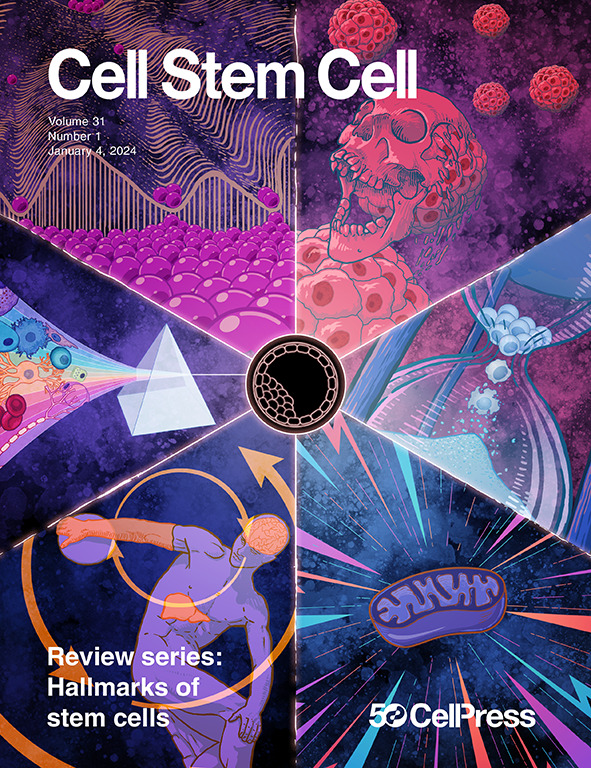通过CRISPRa编程将小鼠胚胎干细胞自组织成可复制的原肠胚前胚胎模型
IF 20.4
1区 医学
Q1 CELL & TISSUE ENGINEERING
引用次数: 0
摘要
胚胎干细胞(ESCs)可以自组织成与自然胚胎具有空间和分子相似性的结构。在发育过程中,胚胎细胞和胚胎外细胞通过激活内源性调控元件进行分化,同时通过细胞间相互作用共同发育。然而,将ESCs自组织成胚胎模型的工程调控因素仍未得到充分探索。在这里,我们证明了CRISPR激活(CRISPRa) Gata6和Cdx2附近的两个调控元件产生类似于原肠胚形成前小鼠胚胎的胚胎模式。活的单细胞成像显示,自我模式是通过细胞内在命运诱导驱动的精心安排的集体运动发生的。在3D中,crispr编程的胚胎模型(cems)与原肠胚形成前的小鼠胚胎表现出形态和转录组相似性。cems允许多种扰动,包括双重Cdx2-Elf5激活以增强滋养细胞分化和层粘连蛋白和基质金属蛋白酶的谱系特异性激活,揭示它们在基底膜重塑和胚胎模型形态中的作用。我们的研究结果表明,最小的内在表观基因组编辑可以将ESCs自组织成具有强大谱系特异性扰动能力的可编程原肠胚前胚胎模型。本文章由计算机程序翻译,如有差异,请以英文原文为准。

Self-organization of mouse embryonic stem cells into reproducible pre-gastrulation embryo models via CRISPRa programming
Embryonic stem cells (ESCs) can self-organize into structures with spatial and molecular similarities to natural embryos. During development, embryonic and extraembryonic cells differentiate through activation of endogenous regulatory elements while co-developing via cell-cell interactions. However, engineering regulatory elements to self-organize ESCs into embryo models remains underexplored. Here, we demonstrate that CRISPR activation (CRISPRa) of two regulatory elements near Gata6 and Cdx2 generates embryonic patterns resembling pre-gastrulation mouse embryos. Live single-cell imaging revealed that self-patterning occurs through orchestrated collective movement driven by cell-intrinsic fate induction. In 3D, CRISPRa-programmed embryo models (CPEMs) exhibit morphological and transcriptomic similarity to pre-gastrulation mouse embryos. CPEMs allow versatile perturbations, including dual Cdx2-Elf5 activation to enhance trophoblast differentiation and lineage-specific activation of laminin and matrix metalloproteinases, uncovering their roles in basement membrane remodeling and embryo model morphology. Our findings demonstrate that minimal intrinsic epigenome editing can self-organize ESCs into programmable pre-gastrulation embryo models with robust lineage-specific perturbation capabilities.
求助全文
通过发布文献求助,成功后即可免费获取论文全文。
去求助
来源期刊

Cell stem cell
生物-细胞生物学
CiteScore
37.10
自引率
2.50%
发文量
151
审稿时长
42 days
期刊介绍:
Cell Stem Cell is a comprehensive journal covering the entire spectrum of stem cell biology. It encompasses various topics, including embryonic stem cells, pluripotency, germline stem cells, tissue-specific stem cells, differentiation, epigenetics, genomics, cancer stem cells, stem cell niches, disease models, nuclear transfer technology, bioengineering, drug discovery, in vivo imaging, therapeutic applications, regenerative medicine, clinical insights, research policies, ethical considerations, and technical innovations. The journal welcomes studies from any model system providing insights into stem cell biology, with a focus on human stem cells. It publishes research reports of significant importance, along with review and analysis articles covering diverse aspects of stem cell research.
 求助内容:
求助内容: 应助结果提醒方式:
应助结果提醒方式:


